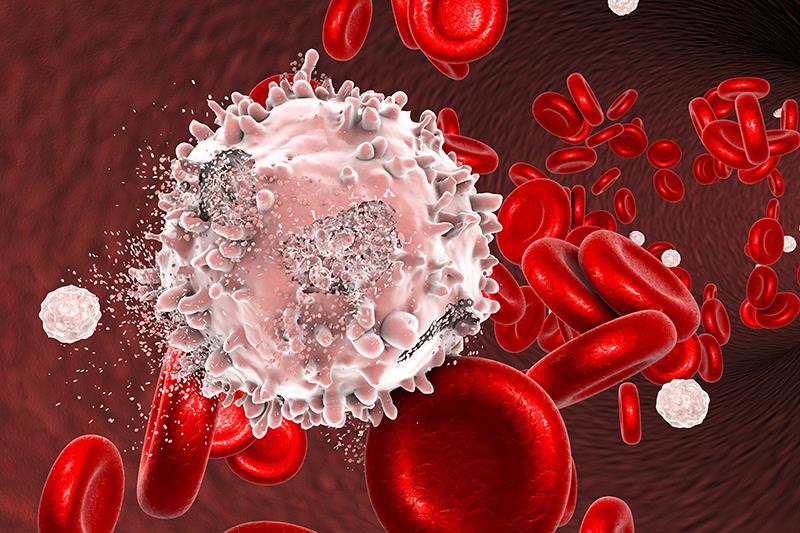STAMP inhibitor bests all TKIs in pivotal head-to-head CML study





In the phase III ASC4FIRST study, asciminib – the first BCR::ABL1 inhibitor to Specifically Target the ABL Myristoyl Pocket (STAMP) – trumped all investigator-selected tyrosine kinase inhibitors (IS-TKIs; imatinib, nilotinib, dasatinib, and bosutinib) for the treatment of newly diagnosed Philadelphia chromosome-positive chronic myeloid leukaemia in chronic phase (Ph+ CML-CP).
Both primary objectives – week-48 major molecular response (MMR) rate with asciminib vs all IS-TKIs, and with asciminib vs IS-TKI within the imatinib stratum – were met with high statistical significance, noted Professor Andreas Hochhaus from the Jena University Hospital, Jena, Germany.
This trial comprised 405 adults with newly diagnosed Ph+ CML-CP who have had no prior TKIs. They were randomized 1:1 to receive oral asciminib 80 mg QD (median age 52 years, 65 percent men) or IS-TKIs at standard label doses (median age 50.5 years, 61 percent men). Both arms were further stratified into the imatinib or second-generation (2G) IS-TKI strata. The median follow-up for asciminib and IS TKIs was 16.3 and 15.7 months, respectively.
At week 48, MMR rates were superior with asciminib vs all IS-TKIs (67.7 percent vs 49 percent), and with asciminib vs IS-TKI within the imatinib stratum (69.3 percent vs 40.2 percent). The respective rate differences were 18.9 percent and 29.6 percent (adjusted one-sided p<0.001 for both). [EHA 2024, abstract S103]
“The cumulative response curve showed a very early distinction [between arms in terms of] the incidence of MMR, with more than 25 percent at week 12. It is very early, and was not observed previously with other TKIs,” said Hochhaus.
Week 48 also saw higher early and deep molecular responses with asciminib vs all IS-TKIs (89.6 percent vs 70.1 percent [early MR (EMR)], 38.8 percent vs 20.6 percent [MR4], and 16.9 percent vs 8.8 percent [MR4.5]) and with asciminib vs IS-TKI within the imatinib stratum (88.1 percent vs 59.8 percent, 42.6 percent vs 14.7 percent, and 17.8 percent vs 4.9 percent, respectively).
There were also more patients on 2G asciminib who achieved MMR (66 percent vs 57.8 percent), EMR (91 percent vs 80.4 percent), MR4 (35 percent vs 26.5 percent), and MR4.5 (16 percent vs 12.7 percent) compared with those on 2G IS-TKI.
“Subgroup analysis showed the advantage of asciminib [over IS-TKIs in terms of MMR rates] for all ELTS* subgroups, in both male and female patients, and in all age groups,” said Hochhaus.
Asciminib had favourable safety and tolerability than imatinib and 2G TKIs as reflected by the lower rates of grade ≥3 adverse events (AEs; 38 percent vs 44.4 percent and 54.9 percent) and AEs leading to discontinuation (4.5 percent vs 11.1 percent and 9.8 percent) and dose modifications (30 percent vs 39.4 percent and 52.9 percent).
The most frequent grade ≥3 cytopenias with asciminib were thrombocytopenia (13 percent), neutropenia (10 percent), and anaemia (1.5 percent).
All-grade arterial-occlusive events (AOEs) were infrequent with asciminib (1 percent). “As the incidence of AOEs is known to increase with longer exposure, longer follow-up is needed to better assess the long-term risk,” noted Hochhaus.
Potential therapy of choice for CML
“Many newly diagnosed patients do not achieve optimal response with standard TKI therapy,” Hochhaus said. “[Moreover,] long-term TKI use is frequently associated with AEs, such as renal failure, pleural effusion, and gastrointestinal and cardiovascular events. The persistent low-grade side effects negatively affect patient adherence.”
ASC4FIRST is the only head-to-head trial against all current standard-of-care frontline TKIs. Overall, the study showed significantly superior efficacy and excellent safety and tolerability with asciminib vs all standard frontline TKIs in this patient subgroup. High rates of early and deep responses were also achieved with asciminib.
“By demonstrating better safety and tolerability and faster, deeper responses vs imatinib and 2G TKIs, asciminib can be the therapy of choice for CML, optimizing the potential to meet treatment goals without needing to switch,” said Hochhaus and colleagues.